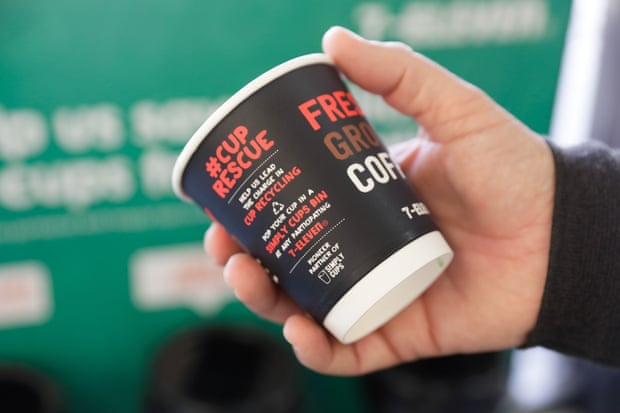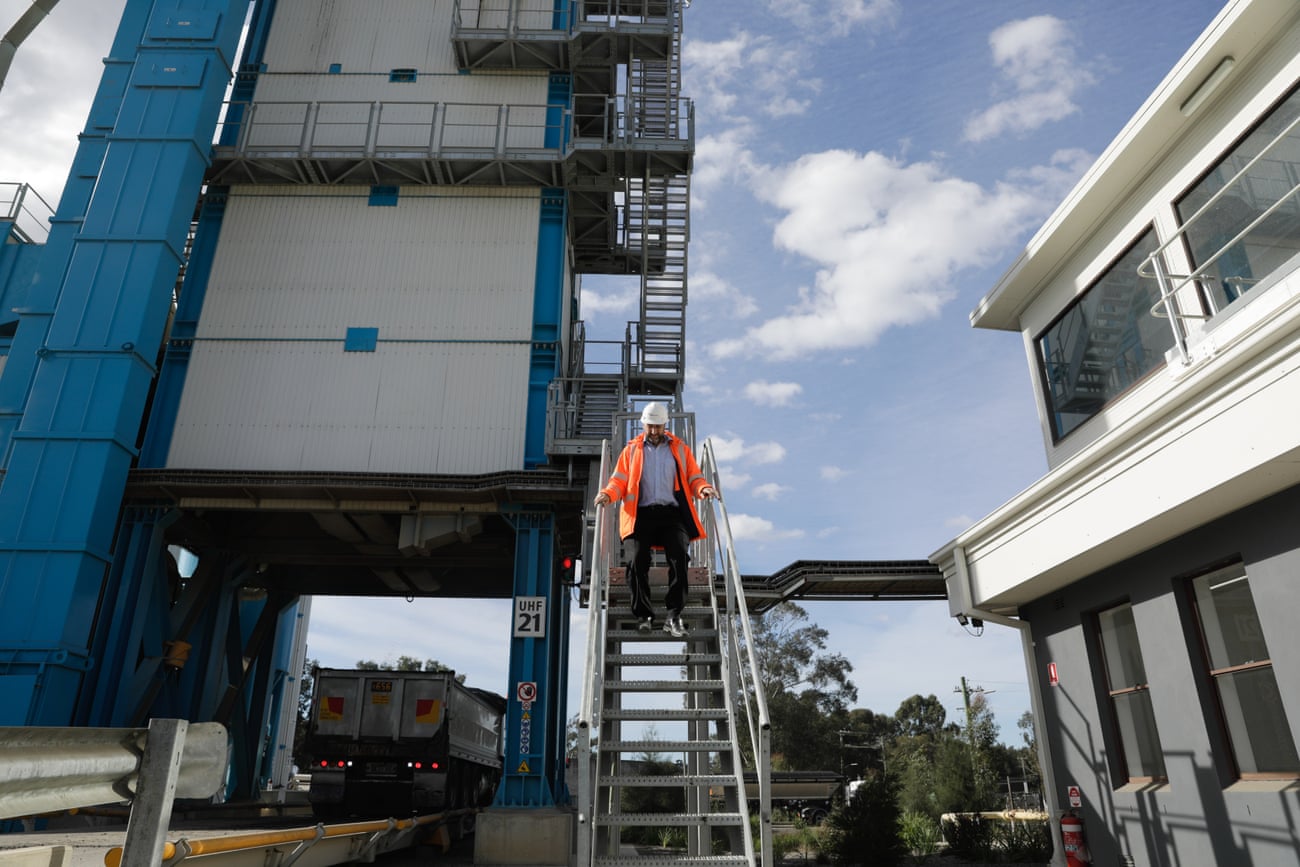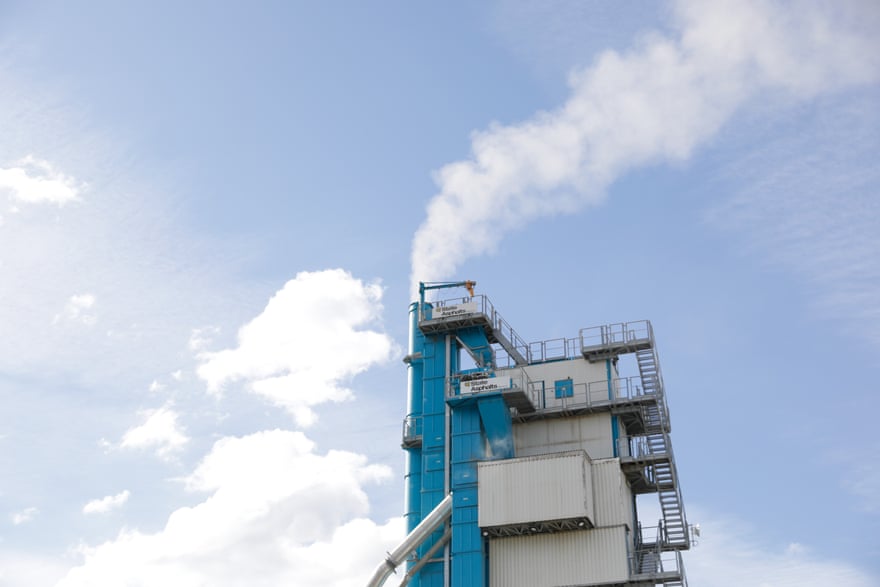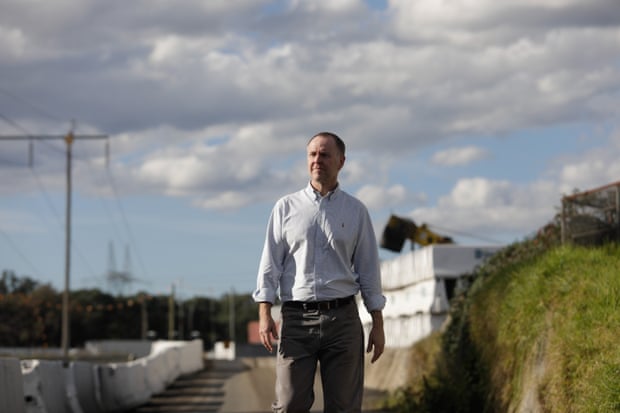This man turns discarded coffee cups into roads
In a secret location in an industrial area in western Sydney, a test strip of asphalt is being laid.
But this is no ordinary road.
The 50-metre strip stretching out into the hot afternoon sun is held together by an unusual material. The gooey cellulose that binds a road surface together is usually imported from overseas, but here it has been sourced locally: from the paper, plastic, lids and liners of coffee cups that were once destined for landfill.
[caption id="" align="alignnone" width="620"] A test strip of road which incorporates coffee cups from the Simply Cups program. Photograph: Carly Earl/The Guardian[/caption]
A test strip of road which incorporates coffee cups from the Simply Cups program. Photograph: Carly Earl/The Guardian[/caption]
For months now, heavily loaded trucks have rolled back and forth over this asphalt and the surface has held up without cracking. The product has been put through a machine test that flexes it until it fails. So far, it has done everything a road surface is expected to do, and then some, says John Kypreos, director of State Asphalt Services. “It’s a better performance product than what we were producing before.”
Exactly how much of the asphalt was once part of a takeaway coffee cup is top secret, according to Kypreos. Ask too many questions and you’re hit with the same answer: that’s the “secret herbs and spices”.
But the western Sydney asphalt manufacturer is on the cusp of rolling out the first roads in Australia surfaced with recycled waste from coffee cups, as part of a collaboration with recycling program Simply Cups. The unusual partnership was brokered by the organisation Closed Loop, which looks for opportunities to achieve what’s known as “net-positive waste”. Kypreos met Closed Loop’s chief commercial officer, Chris Collimore, about a year ago, after a late-night conversation at a birthday party turned to how waste can be used to make roads. Soon after, he saw a Simply Cups collection stand in a 7-Eleven, and got on the phone to Collimore. “It really did start with an idea that John had that he then matched up with our program,” Collimore says. [caption id="" align="alignnone" width="602"] Chris Collimore, the chief commercial officer of Closed Loop. Photograph: Carly Earl/The Guardian[/caption]
Chris Collimore, the chief commercial officer of Closed Loop. Photograph: Carly Earl/The Guardian[/caption]
Net-positive waste
The idea is a simple one: instead of burying waste in landfill, the raw materials of that waste are “upcycled” into new products. It means not only keeping stuff out of landfill, but that fewer virgin resources are consumed in the manufacture of new products. It also means less energy and therefore less greenhouse gas emissions go into the sourcing of those new resources.
That’s what’s called closing the loop, or a circular economy.
But there’s a big but: someone has to buy these recycled products, or else the loop has not actually been closed. And that’s where Closed Loop comes in as matchmaker: pairing up waste streams with companies that can do something with them.
[caption id="" align="alignnone" width="620"] Coffee cups are collected by Simply Cups and then turned into asphalt. Photograph: Carly Earl/The Guardian[/caption]
“It’s not until you’re actually buying back the products that are made out of that [reused] material that you’re … properly recycling,” says Rob Pascoe, the organisation’s founder and head. “It’s not just a matter of lifting the lid on your yellow bin at home and putting stuff in the bin and saying, ‘I’ve done my job’.”
Coffee cups are collected by Simply Cups and then turned into asphalt. Photograph: Carly Earl/The Guardian[/caption]
“It’s not until you’re actually buying back the products that are made out of that [reused] material that you’re … properly recycling,” says Rob Pascoe, the organisation’s founder and head. “It’s not just a matter of lifting the lid on your yellow bin at home and putting stuff in the bin and saying, ‘I’ve done my job’.”
There are three conditions that need to be met to close the loop on a waste stream. First, there has to be a need for the product made from that waste, whether that be fence posts or street furniture. Second, the product made from waste has to be fit for purpose – it has to meet the same standards as the existing version. And third, it must be commercially viable.
Commercial viability isn’t about being cheaper than the non-waste-based alternative, Pascoe says. A product made from recycled materials might be slightly more expensive, but consumers need to remember how much money they’re simultaneously saving on waste disposal.
While coffee cups are attractive because they are an everyday and relatively easily collectable waste stream, the real low-hanging fruit for waste reuse is food waste, says Pascoe. Australia spends more than a billion dollars on artificial fertilisers in an attempt to restore the nutrient capacity of the soil that our food crops are grown in. But at the same time, we’re sending huge amounts of food waste to landfill where it generates methane.
“It’s sheer stupidity,” he says.
[caption id="" align="alignnone" width="602"] State Asphalt Services in western Sydney. Photograph: Carly Earl/The Guardian[/caption]
State Asphalt Services in western Sydney. Photograph: Carly Earl/The Guardian[/caption]
Soft plastics are another one, and here Pascoe disagrees with the move to ban single-use plastics.
“It’s not the plastics that are the problem, it’s what we do with the plastics,” he says. As soon as you put a value on waste, it stops being waste and starts being a resource. “If we do that, it is very, very easy to recycle plastics.”
Pascoe says Australia has failed to invest in the necessary infrastructure to recycle properly. When community enthusiasm for recycling was at its peak, few knew the reality: that the waste we so carefully sorted into recycling bins was being shipped off to China.
“That has become what recycling means, and it’s not what recycling means,” he says. “We should be putting the demand back on people who create the waste to buy back products.”
[caption id="" align="alignnone" width="605"] Waste recovery and reuse has the potential to boost the Australian manufacturing industry. Photograph: Carly Earl/The Guardian[/caption]
Waste recovery and reuse has the potential to boost the Australian manufacturing industry. Photograph: Carly Earl/The Guardian[/caption]
That change needs to come from the top, Pascoe argues, with government procurement policies that mandate a minimum amount of post-consumer recycled materials in products.
“If we can get to that point with governments then we’ve basically won the issue.”
A major boost for industry
Closing the loop doesn’t just offer environmental benefits, there are huge economic benefits as well, according to Gayle Sloan, CEO of the Waste Management and Resource Recovery Association Australia. Every 10,000 tonnes of waste that is recovered, reused, repurposed or recycled creates 9.2 jobs, compared with just 2.4 jobs if that material is sent to landfill or exported.
“We’ve got the chance to create four times as many jobs if we actually think about the materials that we consume and purchase, the supply chains, the collection, the reprocessing and the remanufacturing on shore,” Sloan says. Waste recovery and reuse offers the potential to be a major boost for the Australian manufacturing industry coming out of the Covid-19 pandemic, if it’s done right.
Sloan says the right sort of conversations are beginning within government, with MPs starting to talk about resources instead of waste, and “recognising that it’s not just something we discard in a linear way”.
The joint federal, state and territory governments’ 2019 National Waste Policy Action Plan set a target of banning the export of waste plastic, paper, glass and tyres starting in late 2020, achieving an 80% average recovery rate from all waste streams by 2030, and increasing the use of recycled content by governments and industry. In July this year, the federal government also committed $190m to a new Recycling Modernisation Fund that is intended to generate investment in Australia’s waste and recycling capacity.
Sloan argues Australia also needs a paradigm shift in thinking about how products are manufactured and consumed.
“We need to choose the right materials when we extract resources, and design it in such a way that the value proposition is there and the worth of the material is recognised,” she says. She’d like to see the Australian government mandating the shift to a circular economy strategy, like the European Union has done with its circular economy package.
“It’s not anti-competitive because that is the expectation, that we engage in circular economy that is designing out waste, creating regenerated systems and creating jobs,” she says. “All we’re doing is coming into line with the rest of the world.”Cradle to cradle
Back in western Sydney, the eventual goal for Collimore and Kypreos is a road that is made of 100% recycled material.
Apologising for the “messy” state of his plant, Kypreos points out piles of crushed rock, sand, bitumen and lime, as well as bits of old road surface, which are all set to be transformed into asphalt. He is already using recycled glass to substitute for some of the sand. A complex process of dehydrating and heating turns it all into road surface.
[caption id="" align="alignnone" width="620"] Chris Collimore’s goal is a road that is made of 100% recycled material. Photograph: Carly Earl/The Guardian[/caption]
Chris Collimore’s goal is a road that is made of 100% recycled material. Photograph: Carly Earl/The Guardian[/caption]
There are huge opportunities for industry to make use of waste streams in Australia, Kypreos says, but the infrastructure that’s needed to sort and store waste so it can be easily accessed just doesn’t exist yet. He argues that waste levies should be spent on building that infrastructure, and on encouraging innovative partnerships and projects.
“There’s product in there,” he argues. “It’s just a matter of sitting down and testing and building the science to see if these items that they can pull out of their waste streams are useable or reusable.” But he’s also wary of being seen as the only option. “We’ve got to be careful that we’re not looked at as the new landfill alternative.”
Turning coffee cups into roads is a step in the right direction, but truly closing the loop means ensuring no raw materials are lost at any point along their life cycle. It’s a cradle-to-cradle mentality.
The ultimate goal is to reproduce the same product with recycled material, says Sloan. Plastics – white plastics in particular – would be an easy place to start, she says, because “we can turn that back into a yoghurt container over and over and over – if we choose the right materials, if we have the right collection.”
The coronavirus pandemic has devastated the economy but also presented a unique opportunity: to invest in climate action that creates jobs and stimulates investment, before it’s too late. The Green Recovery features talk to people on the frontline of Australia’s potential green recovery.
Source The Guardian